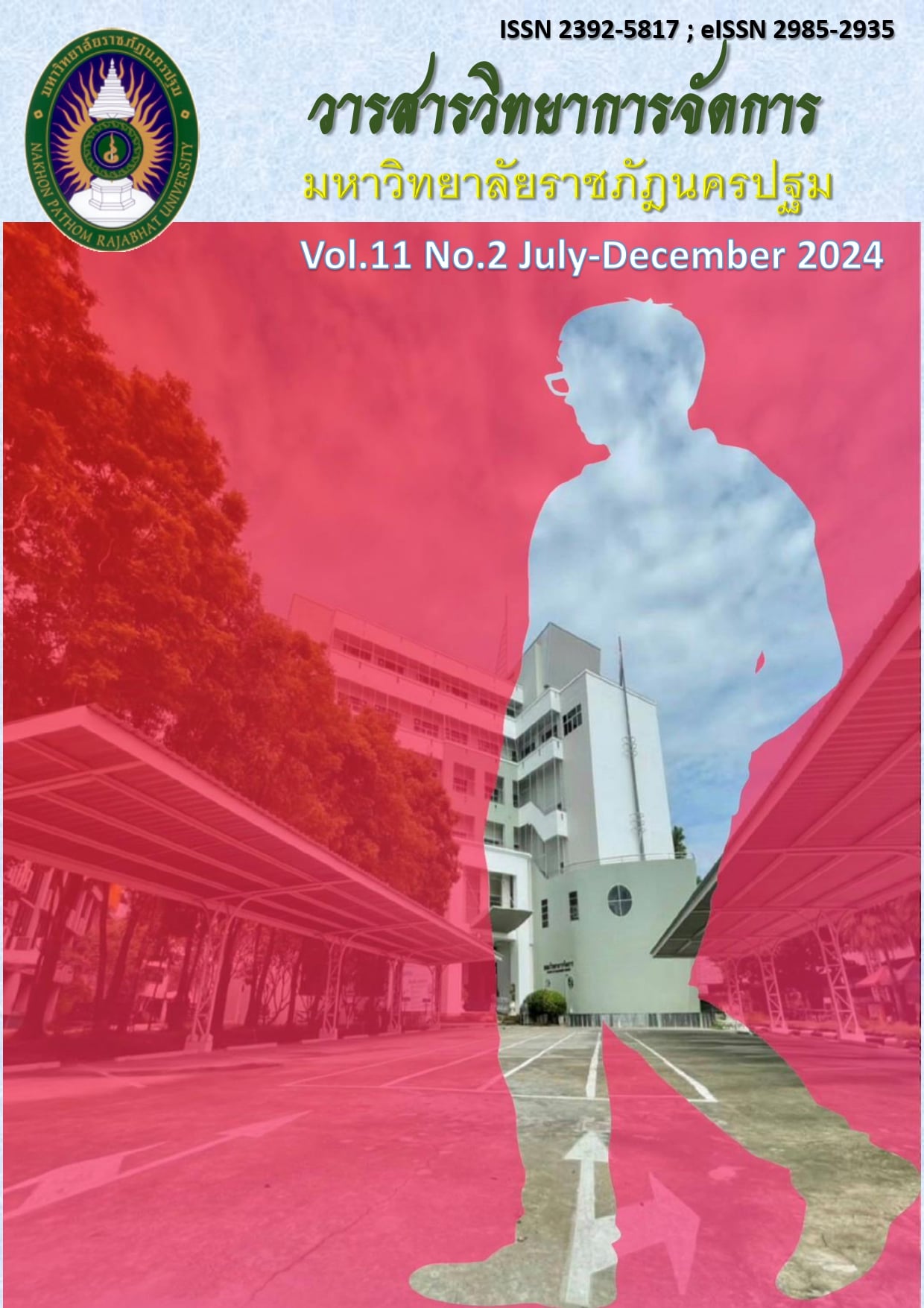The Second-Order Confirmatory Analysis of Modern Marketing Mix for Small and Medium-Sized Enterprises
Main Article Content
Abstract
The findings revealed the following:
1. First-Order Confirmatory Factors of the modern marketing mix for SMEs consist of: creating positive experiences (Experience), providing value for customers to justify spending (Exchange), ensuring easy accessibility through online platforms (Everywhere), and building loyal customers (Evangelism), in that order.
2. Second-Order Confirmatory Factors, based on the highest factor loadings of each component, are: Creating positive experiences: Consistent communication through social media (LY15 = 0.61). Providing value for customers to justify spending: Developing customer profiles by segmenting customers into smaller groups for a more precise understanding of their needs (LY22 = 0.63). Ensuring easy accessibility through online platforms: Effectively using social media by selecting appropriate channels, creating engaging content, and interacting with customers (LY32 = 0.55). Building loyal customers: Establishing business partnerships through collaborations with influencers and e-commerce platforms (LY45 = 0.52), respectively.
Article history: Received 5 July 2024
Revised 1 October 2024
Accepted 4 October 2024
SIMILARITY INDEX = 10.11%
Article Details

This work is licensed under a Creative Commons Attribution-NonCommercial-NoDerivatives 4.0 International License.
The views and opinions of the article appearing in this journal are those of the author. It is not considered a view and responsibility of the editorial staff.
References
Akbar, A., & Sinaga, J. B. (2023). Design Website for Digital Promotion SMEs Product by Optimize
SEO Techniques. International Journal Of Computer Sciences and Mathematics
Engineering, 2(2), 231-240.
Amaral, A., & Peças, P. (2021). SMEs and Industry 4.0: Two case studies of digitalization for a
smoother integration. Computers in Industry, 125, 103333.
Aripin, Z. A., Pynatih, N. M. N., & Artini, N. R. (2024). Collaboration Of Consumer Resources For
Service Innovation In Social E-Commerce: The Effects Of Social Media Influencer
Mediation. JIS SIWIRABUDA, 2(1), 22-30.
Boonmalert, W., Ayasanond, C., Phoothong, B., & Chaitorn, T. (2021). A causal influence model
of innovation and digital marketing on the small and medium enterprise (SME)
performance in Thailand. European Journal of Molecular & Clinical Medicine, 8(03),
-72.
Caliskan, A., Özkan Özen, Y. D., & Ozturkoglu, Y. (2021). Digital transformation of traditional
marketing business model in new industry era. Journal of Enterprise Information
Management, 34(4), 1252-1273.
Chaffey, D., & Ellis-Chadwick, F. (2019). Digital Marketing: Strategy, Implementation, and Practice. Pearson.
Chen, J., Liu, L., & Wang, Y. (2020). Business model innovation and growth of manufacturing
SMEs: a social exchange perspective. Journal of Manufacturing Technology
Management, 32(2), 290-312.
Cruz, E., Orts-Escolano, S., Gomez-Donoso, F., Rizo, C., Rangel, J. C., Mora, H., & Cazorla, M.
(2019). An augmented reality application for improving shopping experience in large
retail stores. Virtual Reality, 23, 281-291.
Dwivedi, Y. K., Ismagilova, E., & Hughes, D. L. et al. (2021). Setting the future of digital and social media marketing research: Perspectives and research propositions. International Journal of Information Management, 59, 1-37.
Edelman, D. (2020). Building Brand Evangelists in a Digital World. Harvard Business Review.
Fei, L., & Kenikasahmanworakhun, P. (2023). Online Marketing Mix and Online Business Quality Affecting Customer’s Satisfaction: A Case of Asiapac Net Media Limited, China. Journal of Value Chain Management and Business Strategy, 2(2), 1-18.
Forrester Research. (2022). Mastering the art of omnichannel retailing. Retrieved from https://www.forrester.com/report/mastering-the-art-of-omnichannel-retailing/RES129320
Hair Jr., J.F., Black, W.C., Babin, B.J., & Anderson, R.F. (2010). Multivariate Data Analysis: A
Global Perspective, (7th ed.).New Jersey: Pearson Prentice Hall.
Kedi, W. E., Ejimuda, C., Idemudia, C., & Ijomah, T. I. (2024). AI software for personalized
marketing automation in SMEs: Enhancing customer experience and sales. World
Journal of Advanced Research and Reviews, 23(1), 1981-1990.
Kotler, P., & Armstrong, G. (2018). Principles of Marketing (17th ed.). Pearson.
Lauterborn, R. (1990). New Marketing Litany: 4Ps Passé; C-Words Take Over. Advertising Age.
Limna, P. (2023). Unveiling the 4Es Marketing Strategy: Factors Influencing Online Shopping Behavior Among Consumers in Krabi, Thailand. Disciplinary Journal Buriram Rajabhat University, 7(2), 1-11.
Mir-Bernal, P., & Sadaba, T. (2022). The ultimate theory of the marketing mix: A proposal for marketers and managers. International Journal of Entrepreneurship, 26(S4), 1-22.
Oye-oluwafemi, F. A. (2024). Need-Based Evangelism as a Tool for Economic Empowerment
and Poverty Alleviation in Nigerian Pentecostal Churches. British Journal of
Multidisciplinary and Advanced Studies, 5(5), 24-43.
Peter, K., Shang, B., & Dabija, D-C. (2021). Application of the 4Es in Online Crowdfunding Platforms: A Comparative Perspective of Germany and China. Journal of Risk and Financial Management, 14(2), 1-19.
Potjanajaruwit, P. (2023). Innovation and Marketing Capabilities of Small and Medium-sized
Enterprises (SMEs) in Thailand. International Journal, 10(4), 1721-1731.
Rittiboonchai, W. (2021). Behavioral intention model to purchase organic vegetables through
electronic commerce systems and multi-channel marketing. RMUTT Global business
accounting and finance review.5(2).24-35
Ryu, S., & Park, J. (2020). The effects of benefit-driven commitment on usage of social media
for shopping and positive word-of-mouth. Journal of Retailing and Consumer
Services, 55, 102094.
Saghiri, S., & Mirzabeiki, V. (2021). Omni-channel integration: the matter of information and
digital technology. International journal of operations & production management,
(11), 1660-1710.
Sassanelli, C., & Terzi, S. (2022). The D-BEST Based digital innovation hub customer journey
analysis method: Configuring DIHs unique value proposition. International Journal of
Engineering Business Management, 14, 18479790221124634
Schiffman, L. G., & Wisenblit, J. (2019). Consumer Behavior (12th ed.). Pearson.
Sohal, A., & De Vass, T. (2022). Australian SME's experience in transitioning to circular economy.
Journal of Business Research, 142, 594-604.
Solomon, M. R. (2018). Consumer Behavior : buying, having, and being (12th). Boston: Pearson. Chicago Style.
Stancu, A., Filip, A., Roșca, M. I., Ioniță, D., Căplescu, R., Cânda, A., & Roșca, L. D. (2020). Value
creation attributes—clustering strategic options for Romanian SMEs. Sustainability,
(17), 7007.
Suherlan, S., & Okombo, M. O. (2023). Technological Innovation in Marketing and its Effect on Consumer Behaviour. Technology and Society Perspectives (TACIT), 1(2), 94-103.
Wicaksono, T., Nugroho, A. D., Lakner, Z., Dunay, A., & Illés, C. B. (2021). Word of mouth,
digital media, and open innovation at the agricultural SMEs. Journal of Open
Innovation: Technology, Market, and Complexity, 7(1), 91.

